Charles Dickens knew how to touch people's consciences. But did you know that "A Christmas Carol" was written with the intention of paying off the debts of an English novelist? The financial aspect by no means obscures the timeless value of Dickens' work. It is worth knowing, however, that before he became a valued, wealthy artist, he also tasted the bitterness of poverty in his life. He was also quite a womanizer!
And it is probably thanks to the wealth of experiences that we can now get to know his full-blooded heroes from various classes of Victorian society. And by the way, see the socio-historical panorama of 19th-century England ...
To be like Oliver Twist
The paintings created by Dickens' pen are truly extraordinary, because the period in which he lived can be described as dynamic, and in many respects a breakthrough. Born in 1812, a few years before the final end of the Napoleonic Wars, and during the Great Industrial Revolution, he spent his early childhood in port cities on the south coast of the United Kingdom.
In Landport, near Porstmouth and Rochester, where Dickens Sr. served as an admiralty clerk, adolescent Charles spent the best moments of his life. Or so he used to think about them decades later. Although the tendency to idealize early youth is something natural, in this case it is difficult to talk about a mistake - having a happy home, loving parents and an ordinary sense of security is a value in itself. Unfortunately, nothing lasts forever.
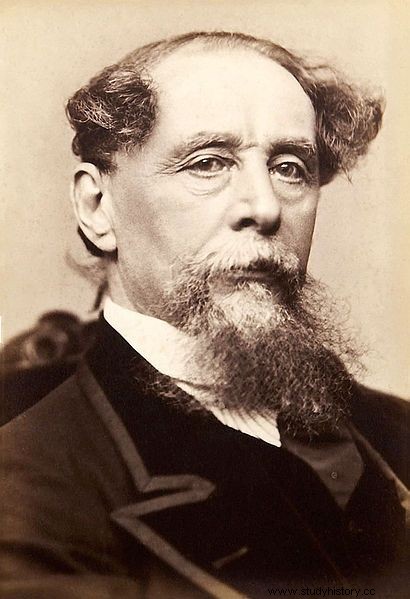
Charles Dickens led a very interesting life
Because when in 1822 he and his whole family moved to London, many things soon changed for the worse. Father's debts made the dickens' future loom with the specter of poverty, especially since the main breadwinner of the family was placed in a penal arrest . In this way, the entire responsibility for the fate of his relatives fell literally on the shoulders of Karol. Working in a shoe polish factory, as well as other odd jobs, was hard and exhausting for him, not only in terms of physical activity. The world of a young boy who, until recently, was reading rogue stories or "The Cases of Robinson Crusoe", has undergone a great, irreversible change. Despite the fact that childhood fantasies were not completely superseded, the prose of gray life began to dominate in him.
Dickens was, in a way, someone like Oliver Twist. Resolute, full of spirit, lonely boy who bravely faced new challenges . Researchers dealing with his life claim that he had a very hit character who could successfully help him find himself in the form of an actor appearing on the stage of London theaters. This was also the unfulfilled dream of an English writer, known as a brilliant observer of the everyday life of the Empire's inhabitants. No wonder, after all, we know that his social sensitivity to the harm of the poorest had real grounds.
Through the eye of the reporter
Soon, however, the card turned around. The relative financial peace of the family allowed him to continue his education, although it must be admitted that from an early age Dickens tried to take care of his education and intellectual development himself. However, his next job, this time as a simple court clerk, tired him with routine, and the judges - together with other officials - seemed to him to be people with extremely uninteresting characters. Anyway, aberrant observations were sometimes expressed in fictional characters outlined on the pages of literature.
Dickens was much more satisfied with the work of a parliamentary rapporteur and, above all, a journalist working for London reform magazines. His eyes and ears were then open to reality . The hustle and bustle in the streets of the metropolis, international trade contacts, dialogues between tramps, romances from high society, small quarrels, big scandals ... The prose of life, written against the backdrop of the industrial revolution, had its dramatic accents. The demographic explosion initiating the process of technological and economic changes has also changed the socio-cultural image of the world. The neglect of agriculture, the increase in class differentiation, and the discrepancy between the living standards of rich capitalists and poor workers - these elements can be seen in the works of Dickens, who in fact became the chronicler of the history of London at that time.
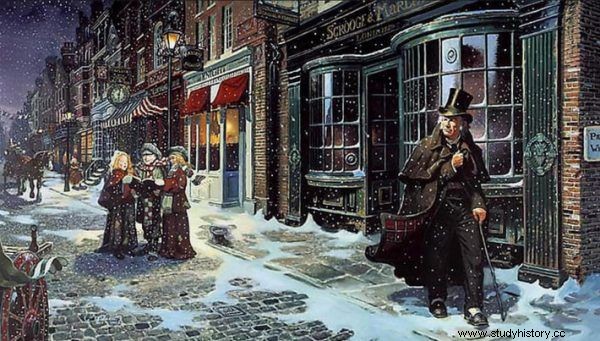
Charles Dickens is without doubt one of the most famous English writers
This is also how he began his literary career. Short satires, stories appearing in English magazines, known today as "Szkice Boza" which, combined with illustrations by George Cruikshank, perfectly portrayed the image of 19th century England. What he did not always write about directly should also draw our attention.
London's Don Juan
The Victorian creator was an incomparable womanizer. His first, great but unfulfilled love appeared in the guise of Maria Beadnell, the banker's daughter which, due to Dickens's less prestigious work, did not actually allow seeing young people. Another issue is Maria's ambiguous attitude towards Karol. Moderate interest was displaced by growing distance, with the result that the romance ended quickly and hopelessly. As it turns out - until then.
For most of his life, the novelist was associated - at least officially - with only one woman. When Catherine Hoghart, the daughter of an English journalist, was married in 1836, it seemed as if it would be a harbinger of a family happiness that Dickens especially lacked in his youth. Ten children, increasingly successful in the field of literature, as well as a loving wife provided the warmth of a home . However, the same strength of calm was provoking new questions in him.
Our hero did not feel happy with a woman who, although faithful, did not provide him with closeness in the sphere of his interests. In his memoirs, he characterized her as a person without good manners, sensitivity, and sufficient intelligence. Moreover, Dickens was paying disturbingly much attention to his lovely sister-in-law helping with the rearing of the offspring. It was her death that brought deep mourning to end the artist's platonic feeling.
After a dozen or so years from the marriage with Katarzyna, Maria Beadnell appeared on the horizon again. Dickens' popularity must have attracted attention and, consequently, the secret meeting of two would-be lovers. The man was incredibly excited about this fact, but only until he saw Maria. Why? Deprived of her feminine grace, delicate figure, personal charm that he remembered from the past, she was a great disappointment for him . Hence, it was again impossible to talk about any relationship, although the second time it happened for completely different reasons.
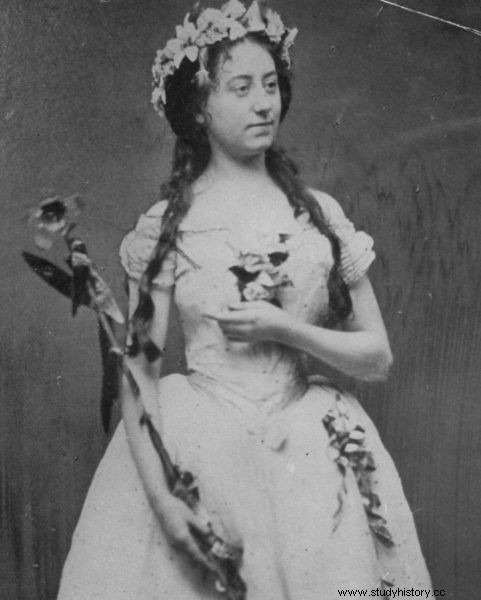
Dickens' romance with the much younger Ellen lasted several years
The biggest scratch on the impeccable, as it sometimes seems, image of Dickens turned out to be his friendship with Ellen Ternan, an 18-year-old actress with whom the then 45-year-old novelist fell in love . The fiery and forbidden romance, however, was kept in strict secrecy. However, in Victorian England with a strong, moral corset, the very scandal was the divorce from Catherine. What about the secret relationship with Ellen? It was said to last several years, during which lies and fear of public opinion multiplied.
A relatively little-known, spicy fragment from Dickens's history becomes the basis for studies and creative interpretations today. Particularly interesting in this regard are the book "The Secret Lover of Dickens" by Claire Tomalin and "The Woman in Hiding" with Ralph Fiennes, who in the 2013 film portrays the protagonist of our considerations. After all, life itself is the most inspiring, although in this case it is sometimes difficult to be proud of, let alone share. But that doesn't mean Dickens didn't do it in his stories.
Life in a novel written down
The aforementioned "Oliver Twist", the novel "David Copperfield" or the fairy-tale "Storehouse of Curiosities" are just some of the titles that refer us to the autobiographical tropes in the work of Charles Dickens. It is also one of the keys to understanding the original framework of the Englishman's works, who is an extremely popular figure not only today, but also over the past centuries. His books, most frequently published in episodes, have become a hot topic among ordinary Londoners over and over again. Amazing? The "Pickwick Club" is a good example here.
The adventurous journeys of the members of the eponymous club, as well as their leader, Samuel Pickwick, sold a staggering 40,000 copies a month, while the standard circulation of similar stories oscillated in the range ten times smaller. The merit of this phenomenon turned out to be the inclusion in the row of adventurous fates, also comments on social injustice, harm to the poorest in short - everything that concerned the everyday life of a great metropolis. The fate of the episodes may arouse the right associations with TV series among us today. The medium of expression has changed, but the attractiveness of fictional worlds is similarly inspiring.
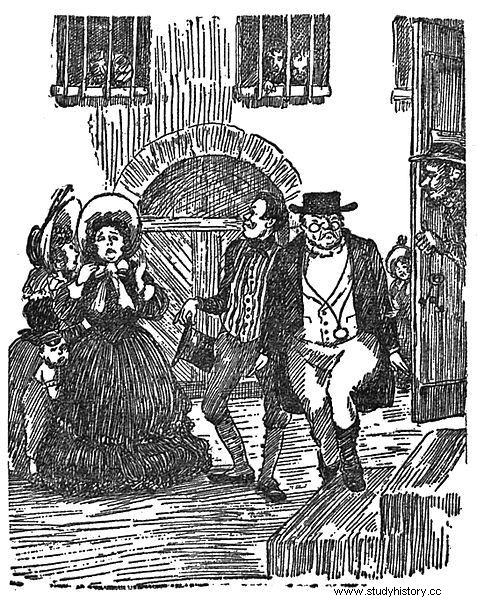
The Pickwick Club has turned out to be a real phenomenon!
The evenings, when Dickens sat down most of the time to write, must have been conducive to the revival of memories. No wonder, then, that in the figure of Wilkins Micawber from "David Copperfield" we can find the figure of a father who was imprisoned for unpaid debts, and the very poignant death of his sister-in-law, Mary, is reflected in "The Warehouse of Curiosities", a place luring with the secrets of the past and nostalgia. Biographers also point to a number of other characters or recurring motifs. A characteristic element of the work of Dickens is also taking up topics related to childhood in the perspective of sadness, loss and injustice. Just like it is in the multi-screened "Oliver Twia". This does not mean, however, that the Englishman did not share his hope. Especially during the holidays.
Unknown Christmas stories
The story of Ebenezer Scrooge is undoubtedly one of the most famous works by Charles Dickens today. The story referring to Christmas Eve turned out to be a success, however spectacular and unexpected . As it was said at the beginning - he wanted to create a text that would ensure him, above all, a way out of the financial hole in which he found himself after the publication of a rogue novel entitled simply as "Martin Chuzzlewit". How exactly did he do it?
A frosty December holiday day. Particular mood. An old man with a difficult character with a painful past. Here is the hero. Metaphysical accents and - this time in turn - a perfectly illuminated description of the bourgeois environment, as well as an endearing representation of the poorest, simple people. Dickens's "A Christmas Carol" is a perfect depiction of the spirit of the Victorian era. On the one hand, searching for traditions, cultivating family and religious values, while looking for what is new. The premiere of the famous story, dating back to 1843, is also the time when the first Christmas card appeared, and the smell of Christmas trees and the custom of family caroling with songbooks have become noticeable in the households.
The cult morality play is not, however, the only one in a series of short stories published under the name "Tales of Christmas Eve". "Cricket behind the chimney", in which elements of fairy tales are revealed by the title insect and fairy-tale elves, "Haunted", where the mysterious Specter offers an unusual arrangement to a professor who wants to get rid of the worst memories of his life, "Bells that ring when the old year passes away and the new is coming ", with the mystical aura of life near the church, as well as the philosophical" Battle for Life "- in each of these stories we can see a deeply rooted concern for man, as well as the joy that flows from the festive time.
For Dickens, although he often criticized institutional religion, did not shy away from metaphysical reflections and works devoted to the figure of Jesus, although he sometimes questioned his sanctity. There is no doubt, however, that the humanistic thoughts contained in the Englishman's works can still be a universal compass of values for many contemporary readers.
The moral voice of the nation
A figure from a bronze statue made during the Victorian era. A writer of impeccable manners, artistic genius and the appearance of a noble, cheerful old man. This is the characteristic most common in relation to Charles Dickens. As it turns out, the truth is not always crystal clear. Torn by incomprehensible passions, wanting to create family happiness, he was able to destroy it himself. Probably neither the childhood experiences, nor the difficult character and belief in one's own greatness helped in this place.
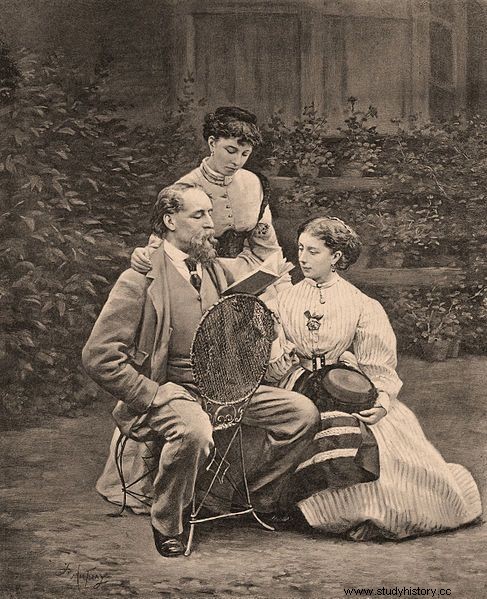
Karol Dickens with his daughters
However, the holiday memory should not take on such dramatic tones. Realism, social satire and sensitivity in portraying the most vulnerable were admired not only by ordinary people, for whom he was the moral voice of the nation. Dickens's work was appreciated by other great writers - Leo Tolstoy, Gilbert Keith Chesterton and George Orwell. After his death in 1870, it was decided to accept a solemn mourning in many English homes. And his "A Christmas Carol" with which we started our reflections?
After all, it is an eternally living classic of literature praising the family Christmas, promoting generosity for the poor, understanding towards another, stranger, depicting archetypal figures symbolizing greed, goodness, transformation, as well as the then popularized expression "Merry Christmas!" I this hard-to-define mood of weirdness created not only by ghosts resembling the most important human values. One of the Victorian delusions is still played by Charles Dickens today. It carries a warning and hope. We cannot deny him such merit.
Bibliography:
- Stefan Majchrowski, Dickens. Biographical story. People's Publishing Cooperative, 1984.
- "Dickens, Charles." Dictionary of National Biography.
- Agata Buda, The Victorian Novel and Its Twentieth-Century Life, UTH Publishing House 2014.
- A brief history of English literature, Państwowe Wydawnictwo Naukowe, Warsaw 1966.
- Krystyna Kaplan, London in the days of Sherlock Holmes, Polish Scientific Publishers PWN 2016.
